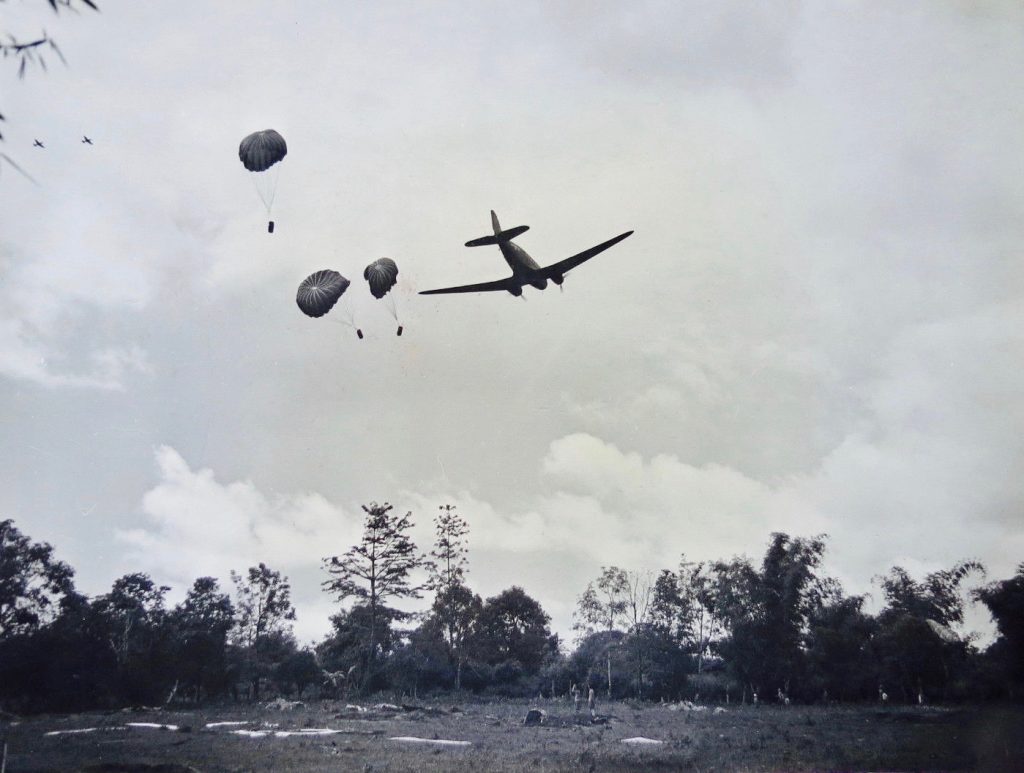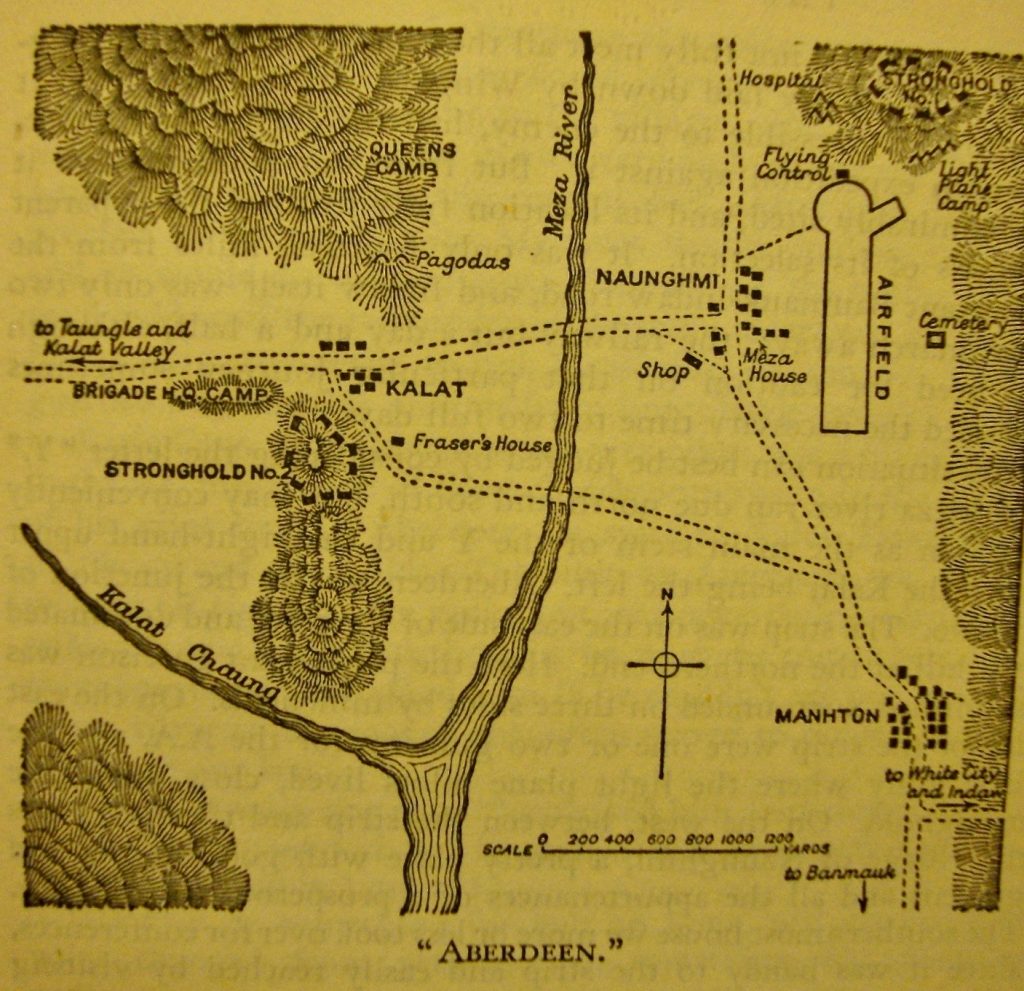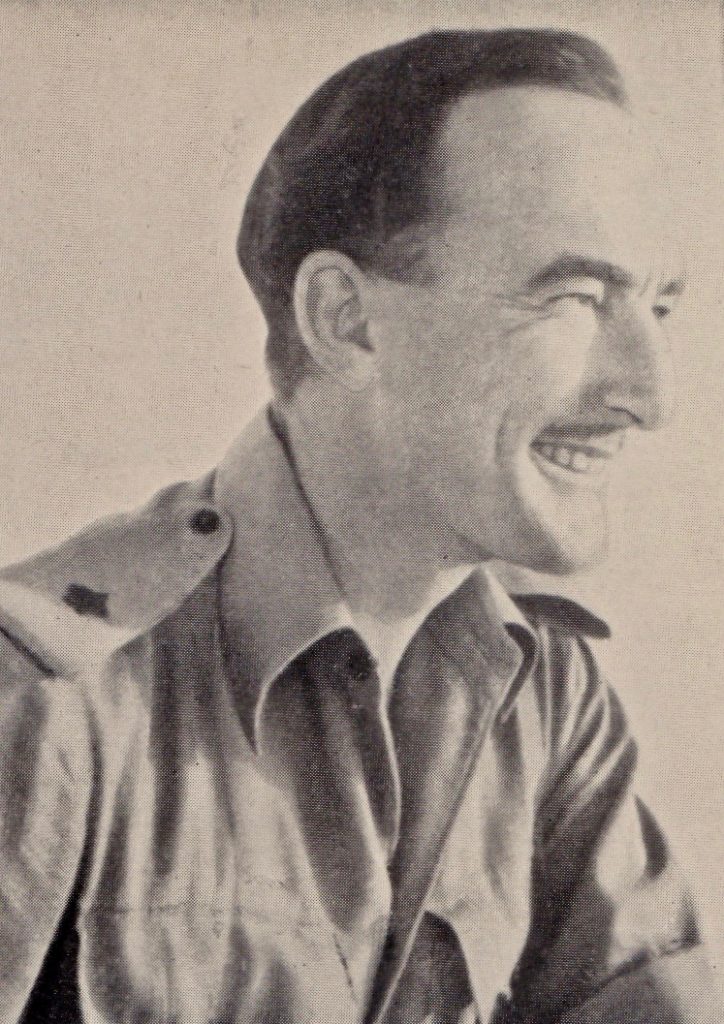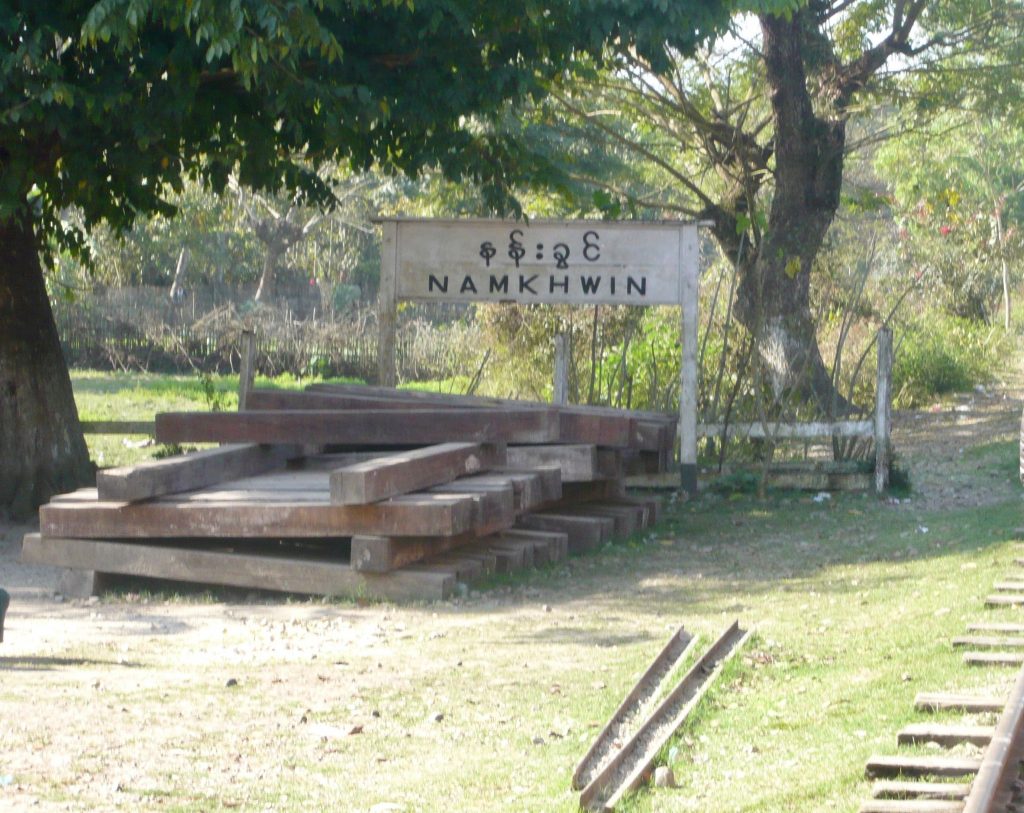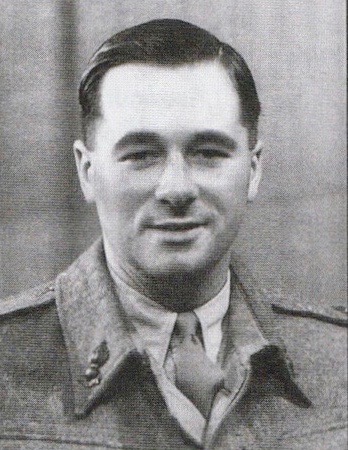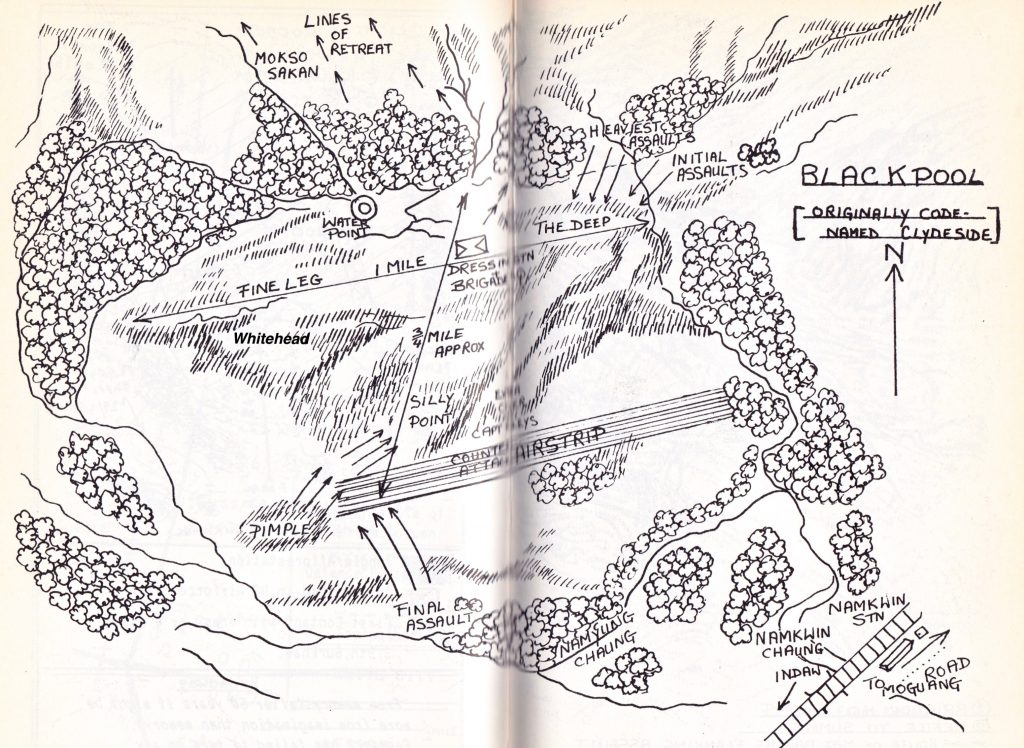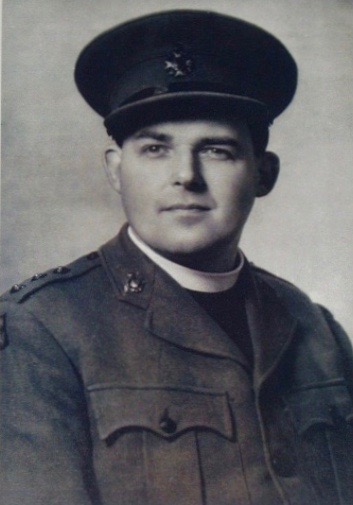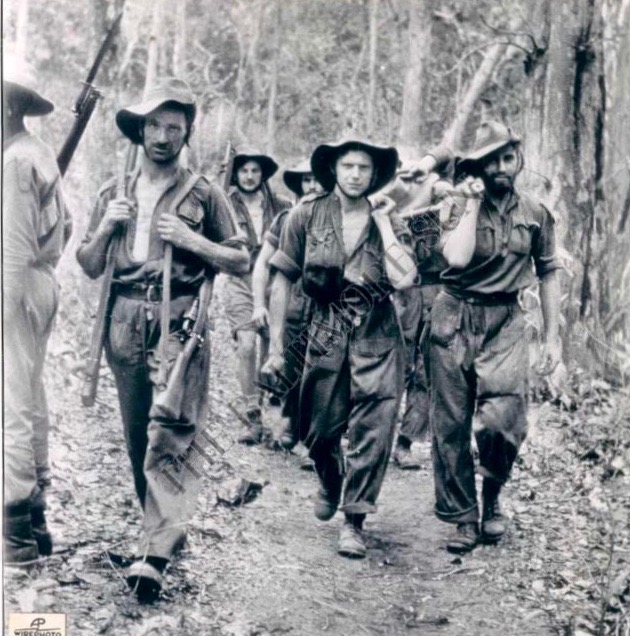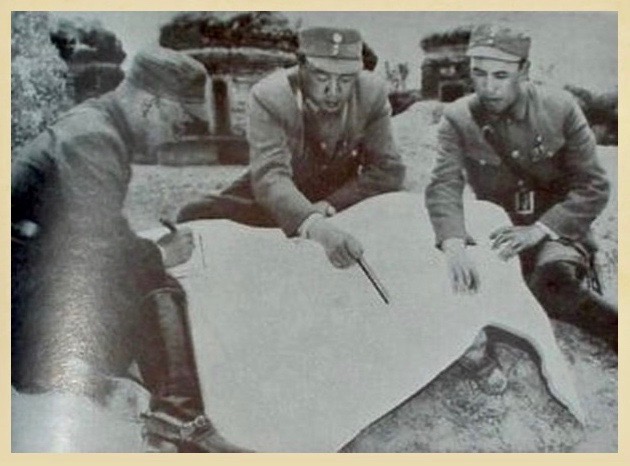REMEMBERING OPERATION THURSDAY 75 YEARS ON
Wingate hoped that Indaw’s capture would trigger the fly-in of forces powerful enough to be decisive in the Burma campaign, but the Indaw attack stalled and the Imphal/Kohima struggle continued. Wingate was told the cupboard was bare and that Indaw, if taken, could not be garrisoned and “developed”. Now the priority was to destroy enemy dumps and lines of communication around Indaw, contributing to a wider intensification of efforts to disrupt supply lines serving the Japanese 18th Division, opposing Stilwell’s Chinese, and the 15th and 31st Divisions attacking Imphal. There was also the hope that more action around Indaw would slow up any Japanese attempt to pursue Special Force in strength as it moved north.
—ooo—
The Japanese reorganised in April, to attack the 14th Army with 15th, 31st and 33rd Divisions, but the 2nd British Division raised the Kohima siege on 18 April and 31st Division went on the defensive. The Chindit-trained 23 Brigade made a valuable contribution to the fighting that turned the tide. The Japanese were doomed, eventually facing eight and a half British and Indian Divisions and powerful air and armoured forces.
The men of the detached 23 Brigade had it no easier than the other Chindits. They also depended on airdrops and often went hungry. Any mishap during a drop caused much anguish. RAF Officer W.A. Wilcox, with 76 Column (2nd Duke of Wellington’s), yelled a warning when a statichute failed. The load plummeted down, struck the ground and burst: “I walked over and gazed at a thick yellow mess which oozed from the battered tins in the basket. Others joined me; there were almost tears in their eyes: ‘Peaches’, someone muttered thickly, ‘the whole bloody fruit ration.’”
On 18th April two Chindit Brigades, 14 and 16, launched fresh, loosely-coordinated attacks on Indaw, 14 from the south and 16 from the north, with Indaw West airfield the priority target. 111 Brigade took over the block on the Banmauk-Indaw road from 14 Brigade’s Blackwatch columns.
The two York and Lancaster columns of 14 Brigade, 65 and 84, called up light aircraft to evacuate 11 casualties, then prepared for the second assault on Indaw. The men bivouacked alongside a mountain stream and rested, using the time to complain about the failures in their latest airdrop, thanks to inferior cotton statichutes. Tempers ran short in the twilight. Paddy Dobney, 84 Column’s Admin. Officer, sought out the offender chopping hollow bamboo, announcing their position across a wide area. He settled the matter by giving the Muleteer in question a hefty boot in the backside.
The main reason for the failure of the first attack on Indaw was lack of water during the approach. Now the second attack stalled, as 14 Brigade received fresh orders to protect White City during its planned evacuation. Nevertheless, they did damage around Indaw, by now heavily reinforced by the Japanese. The two York and Lancaster columns operating south of Indaw in the April 22-26 period were very active. Together with other 14 Brigade columns, the Chindits destroyed over 20 dumps and damaged the railway in 16 places, ambushed a train and attacked two villages and a railway station.
Now on the move to support Brigadier Calvert’s 77 Brigade at White City, 14 Brigade’s nearly 3,000 men and hundreds of animals crossed the railway and headed north, to take up their “floater” defensive role around the Block. It was a gruelling positioning march but they took opportunities to carry out demolitions. Meanwhile, White City stayed relatively quiet. Lack of water was a problem for the Chindits operating outside the Block. The Lancashire Fusiliers’ 50 Column was in dry country west of White City. The men endured extreme thirst. Sometimes it was hard to see the funny side. Administrative Officer Captain Jeffrey: “The sun rose, our tongues and throats became parched and sore and it was difficult to speak. Suddenly, we saw some water buffalo rise up from the ground a hundred yards ahead of us and lumber off in the direction of a village. There we found water, thick, black and evil-smelling, but we boiled it up and drank it, sitting in a circle round the swamp and laughing with relief. Then, 10 minutes later, we came upon a clear, sparkling stream.”
The last big attack on White City came in on April 17. By sheer weight of numbers, the Japanese broke through a section of wire and a bitter fight followed, ending in a counter-attack by the West Africans. The battle area was littered with 200 Japanese casualties. The floaters also did their job. As 7NR neared White City, for example, 35 Column ambushed a Japanese force concentrating to attack the Block from positions around Mawlu. The sister column, 29, set its own trap on the Pinwe-Sepein road south of White City, destroying trucks and killing 41 Japanese.
—ooo—
Most elements of 16 Brigade, who marched into Burma during February, would soon be flown out. On April 19, 45 Recce’s depleted 45 and 54 columns were consolidated into one column (45) and returned to 16 Brigade. They set out for Aberdeen on April 23, but were then told to make for Broadway, at that point seen as a safer bet. They struggled on, hampered by over 40 walking wounded and five seriously injured on mules and the ponies. Trooper Aylen: “I was unable to carry a pack owing to my chest wound and had abandoned everything except rifle, water bottle, half a blanket and a copy of Palgrave’s Golden Treasury.”
They had a shock on April 26. They had called up a light aircraft to fly out the most serious cases, but, instead, were amazed at the arrival of a YR-4 helicopter. Philip Sharpe described the encounter: “Just before midday we were flabbergasted when a helicopter circled the clearing and landed.” It took two wounded and returned later for two more. The handful of helicopters operating in North Burma were very active at this point.
Meanwhile, 23 Brigade’s columns disrupted the supply lines of Japanese forces pulling back from Imphal and Kohima. The main body of Special Force now prepared for a new phase of the campaign. New orders for 111 Brigade called for a move to the Hopin area north of White City, where a new Block would be established, with “floater” defences provided by 3(WA) and 14 Brigades, with 77 Brigade positioned to the east of the railway, opposite the new Block. This plan recognised the inability to hold Broadway, Aberdeen and White City in the pending monsoon, now less than one month away. If the Chindits were to stay in, they had to go north and link up with the Chinese, if the wounded and sick were to live.
Some men had already suffered to such a degree that they were losing the will to live. Private Jim Unsworth, of the King’s Own’s 46 Column, saw something that shook him to the core: “Four men in my Section, all from Birmingham, were sitting at the side of the track as the column passed. No-one said anything to them. When I came up I warned them: ‘You’ve got to carry on. You’ve got no food and the Japanese will pick you up. If you stay here, you’ll never get out.’ They argued with me. They said: ‘We’ll make it back.’ I replied: ‘Will you ‘eck!’ I caught up with Major Openshaw as the column stopped for a 10-minute breather. I told him about the four and he said: ‘You know the rules. We don’t stop for anyone.’ Later that evening a Sergeant Major came in and asked whether anyone knew what had happened to them. I told him my story. As far as I’m aware, I was the last man to see them. They were never heard of again.”
Such cases became more frequent when the monsoon broke. There were also the lost opportunities. One such involved Morris Force. Peter Cane’s 94 Column (4th/9th Gurkhas) was operating independently and had identified Nalong village as a key target on the Bhamo-Myitkyina road. Nalong was a major supply hub for the Japanese 18th Division. Cane was unsuccessful in lobbying for Morris Force to focus on Nalong. He then attacked and burnt Nalong independently on April 22. A few days later, however, a huge convoy of over 130 Japanese trucks arrived at Nalong. Peter Cane called for an air strike – there were now over 300 trucks in the village – but his request was ignored. Frustrated by the lack of action, Cane used up his entire stock of explosives to block the road, but to little effect.
—ooo—
By early May, the strategic situation in Burma had been transformed. The Japanese thrust against Imphal/Kohima had failed. In the Mawlu-Indaw area the Chindits had savaged the 24th Independent Mixed Brigade. There were also some disappointments. Having struggled so hard, for so long, around Indaw, elements of 16 Brigade occupied Indaw West airfield and found it to be unsurfaced – a fair weather strip that would be useless in the monsoon, only a fortnight away.
Now the focus was on support for Stilwell. With Special Force no longer having direct responsibility for assisting IV Corps, there was no longer any benefit in staying as far south as Indaw. The case for going north was made stronger by Stilwell’s slow progress; the main centres of Kamaing, Mogaung and Myitkyina remained in Japanese hands. On April 28 Merrill’s Marauders (3,000 Chindit-trained Americans) and six Battalions of Chinese set out for Myitkyina but their goal was 100 miles distant.
When Slim, Stilwell and Lentaigne met on May 1, they took the decision to transfer Special Force to Stilwell’s command. The toxic combination of Stilwell and the Monsoon sealed the fate of Special Force (with the exception of 16 Brigade and the detached 23 Brigade). The exhausted 16 Brigade was to be flown out, while 23 Brigade remained beyond Stilwell’s reach. Its columns continued to engage the Japanese forces thrown back from Imphal/Kohima.
The plan called for closure of Aberdeen, Broadway and White City before the Monsoon broke. It was now the turn of 14 Brigade (reinforced by the King’s, 3rd/9th Gurkhas and 6NR) to play a major role. The new Block near Hopin would cut the road and rail link to the town of Mogaung. 14 and 3(WA) Brigades were to be responsible for the final garrisoning and subsequent closure of Aberdeen, Broadway and White City, before moving north to support 111 Brigade at the new “Blackpool” Block.
By this stage life in White City had reached new heights of unpleasantness. Bill Williams, Animal Transport Officer with the South Stafford’s 80 Column: “American light plane pilots said they could smell White City when they were above it. Many corpses on the wire could not be buried.” Williams had problems of his own, having been wounded in the leg during a patrol: “I thought little of it at first, having had it cleaned and dressed at the Casualty Clearing Station. Unfortunately, it then started to go wrong. The calf wound became badly infected and I could smell it all the time. I knew it was serious when I developed a lump in my groin.” Williams was flown out by light plane to Broadway and on to India by Dakota, suffering from advanced blood poisoning. His condition warranted five weeks in hospital.
Bernard Fergusson’s 16 Brigade flew out from Aberdeen and Broadway. They had been operating in Burma since the second week of February and the men were at the end of their tether. Bren Gunner John Simon was with 16 Brigade’s HQ Column: “I went in at 12 stone 8 pounds and I came out at 9 stone 3 pounds. When we left Aberdeen I succumbed to malaria. My friend, Les Martindale, had become too weak to carry the Bren. That pleasure became all mine … We were flown out to Sylhat, where the entire Brigade was hospitalised. My Company was the last out. Short of space, the hospital put us in the VD Clinic! Vera Lynn put on a show at the hospital the next day but, for some reason, did not visit us.”
Some men found the nightmare continued when they boarded aircraft bound for India. Gordon Hughes, a Platoon Commander with the Queen’s 22 Column, remembers flying into an horrific electrical storm: “The aeroplane was performing the most hideous gyrations … I threw up and there was vomit all over the place … the mules were no better off. Next moment we seemed to drop hundreds of feet out of control and we began to think that this was the end. The feeling of complete helplessness was appalling, for there was no means of talking to the pilots for reassurance.
“I managed to stagger to my feet and made my way up to the four mules. They were panic-stricken and thrashing about, trying to break loose from their stalls. I really thought the end was near. I tried to calm the animals but they were in such a state that they were implacable. In fact, the right-hand rear animal was in danger of breaking loose. I decided to shoot the animal and prayed that my one shot would not only kill it but the shock would calm the others. I got one of the men to twitch the mule’s ear and put my revolver in the centre of his head, midway between ear and opposite eye. Thank God he dropped dead and there was no apparent ricochet of the bullet. The other mules were so shocked that they ceased their struggling.”
The 45 Recce survivors reached Broadway on May 1. They had begun their march in on February 12 with over 900 men. Seventy-eight days later just over 400 men and 13 officers reached Broadway (including some men not in the original force). Many were in a dreadful condition.
Orders were received to close Aberdeen by May 6, followed by the closure of White City and Broadway within days. On April 28, 111 Brigade had established a rendezvous at Mokso Sakan. The two 6NR columns, 66 and 39, were re-equipped and left Aberdeen to join 111 Brigade. 14 Brigade columns were in position by May 5, to shield the White City closure.
111 Brigade columns gathered at Mokso Sakan on April 28. Blackpool was established at Hopin, around 40 miles north of White City. 14 Brigade would protect the new Block to the west of the railway, with 77 Brigade doing much the same to the east.
Before his untimely death, Wingate had planned for the Chindits to stay in for three months. Now, with the Monsoon approaching, many began to ponder on this “contract”. Jack Masters, now commanding 111 Brigade, told them straight: “There are some of you who think you are nearing the end of your strength. You are wrong. In the past months, you have consumed the surplus energy you built up before coming into Burma. Now you are down to scratch and from now on you will be drawing on your strength. You have not reached your reserves and will not do so for some time. There is a big task still to do.” Despite these words, many Chindits were left with the feeling that Special Force, in some way, had been cheated.
Men learnt to cope with the cruel conditions in their own way. Thirst caused severe suffering. Andrew Sutherland, of 23 Brigade (The Duke of Wellington’s Regiment, 60 Column): “Every morning we drank hot tea, filled our water bottles and then drank all the water remaining in our chaguls, forcing it down if need be. Thereafter, no matter how thirsty we became, we would not touch any water for the whole day. For we had very quickly found that even sipping water made the thirst unbearable. It required a certain amount of willpower but was worth the effort. We would keep our mouths moist by chewing gum from our K-rations.”
—ooo—
As the Monsoon neared, Stilwell’s forces advanced south towards the line Mogaung-Myitkyina. With the monsoon now just weeks away, the Chindits were moving north, closing with Stilwell’s Chinese forces. On May 8, Michael Calvert’s main elements left White City and marched north towards Mogaung. White City was closed during the night of May 9/10. Dakotas flew in to take out the wounded and sick, the 25 pounders, stores and mules. Most men were glad to see the back of it, after a gruelling seven weeks of fierce battles. Even the animals seemed pleased to leave. Captain Bill Towill noticed that the mules “seemed to sense what was afoot, since they lost all inhibitions about boarding transport and jostled with each other and their drivers to board the planes.” Many men had private hopes about being flown out, but it soon became obvious that they were heading away from that possibility. They were making for Mogaung, despite vigorous protestations made by Michael Calvert on their behalf.
The White City rearguard left a maze of booby traps and demolition charges with time fuzes. They were around 24 hours behind the main body. The Japanese made no attempt to interfere with the Block’s closure, but between 1,000 and 1,500 of the enemy died attacking White City. The Japanese were now determined to destroy Calvert’s command. Elements of the 53rd Division pursued them, while the spent 24th Independent Mixed Brigade moved to Indaw for garrison duties. Meanwhile, Chindit formations positioned themselves around the new block – 14 Brigade and the West Africans to the west and 77 Brigade along a ridge to the east. Broadway Stronghold was closed on May 13.
Blackpool Block was established on May 7, with the King’s Own’s 46 Column the first to arrive at the site. They came under fire as they dug in. The early arrivals requested a large drop, including plenty of wire. The King’s Own’s second column, 41, arrived on May 9. At that time, the Block was still known by its original name, ”Clydeside”. It did not become “Blackpool” until May 16.
Timing was crucial. The new Block had to be in place just before White City closed and this had to be achieved before the monsoon. Those goals were met. However, another critical success factor was not achieved – the prompt deployment of 14 and 3 (WA) Brigades for floater protection around Blackpool. Floater forces had underpinned White City’s outstanding success. Unfortunately, the two Brigades did not take the direct approach to Blackpool followed by 111 Brigade. Instead, they struggled over the Bumrawng Massif.
111 Brigade Cypher Officer Richard Rhodes James took a close look at Blackpool: “The position lay on a series of ridge features jutting out from the lower slopes of the hills we had just crossed. They were small ridges but very sharp … Brigade headquarters was sited in the middle, at the top of the highest feature …”
He described the outlook from Blackpool: “A long, narrow stretch of open country directly below, a river and a railway a mile away. Namkwin Village, with its little railway station, a prime target. The road, disappearing north to Mogaung and south to Indaw. On the far side of the valley were more hills and in these hills 77 Brigade was resting, after weeks of fighting at Mawlu; 14 Brigade was away to the south, moving up from Banmauk to protect us and moving, as we thought, very slowly.”
Jack Masters, 111 Brigade’s Commander, had no illusions. He was aware that White City succeeded as it was in the Japanese rear, in contrast to Blackpool. As soon as the King’s Own and Cameronians arrived, they had come under attack by a railway unit based at Pinbaw, five miles up the line. Although second line troops, they attacked five nights in succession. Masters knew he would soon be opposed by first line troops and that his site lacked several critical Wingate requirements, including the need to be beyond the reach of enemy heavy artillery. Bill Smyly, of 3rd/9th Gurkhas: “Blackpool was the best choice under the circumstances but depended on a large body of floaters, which was allocated but did not arrive.”
Blackpool’s shortcomings soon became evident. It was obvious that it would be impossible to construct defences as strong as those of White City and Broadway. Nevertheless, work went on round the clock to build a defensible perimeter. The attack on the first night was followed by heavy shelling in the morning. Some 300 shells landed in the Block, killing 24 and wounding 20. Gliders landed at first light on May 9, carrying American engineers and airstrip construction equipment. One glider stalled and crashed. Another came under Japanese fire. A team of 50 British troops helped build the Dakota strip. By 19.00 on May 10 a rough C-47 strip was ready. The first three transports arrived that night. Records suggest that early flights were suspended due to accidents, but the strip was further improved and it re-opened for C-47 landings the following night. The fly-in priorities included the Block’s 25 Pounders – U Troop of the 160th Jungle Field Regiment. Captain Ronald Swann RA did not find Blackpool to his taste: “A Block was supposed to be sited at a location where the Japs could bring up only mortars and light weapons against it. It was also supposed to be heavily wired, with floater columns providing active defence outside the perimeter. Blackpool had no such floater columns. When the monsoon arrived, the country around was inundated and 77 Brigade could not reach us.”
The first 25 pounders were set into a hill behind the Blackpool defence position known as “Wicket”. All Blackpool’s features were known by cricketing terms. The Gurkhas and King’s Own were in front of the guns, on the forward slopes immediately overlooking the airstrip. Not surprisingly, this sector became the centre of intense, savage fighting. The guns shelled the station, road and rail bridges over the Namkwin Chaung and many other targets. Some Broadway ammunition and the anti-aircraft guns were ferried over to Blackpool.
—ooo—
The Japanese continued their efforts to quickly crush Blackpool Block. A Company-strength attack on May 14 was backed by artillery support. It was repulsed, the Japanese losing 60 killed. They returned the following morning, when another 50 were killed. Air strikes were called in to further punish the enemy. Then the monsoon took hold and air support and supply became more difficult – Lalaghat and Hailakandi were fair weather fields.
The Cameronians’ Padre, Donald Mackay, was one of many with growing misgivings about Blackpool: “We were gravely handicapped by the lack of adequate floater columns … the Brigade due to come to our assistance was still many miles distant. Without their help, we could not both defend the Block and control the position in the surrounding jungle.”
14 Brigade’s progress slowed dramatically when the monsoon broke on May 15. Steep slopes required steps and traverses. Men struggled in deep mud and were forced to manhandle the animals’ loads. Captain John Riggs, 16 Column’s Recce Platoon Commander (Bedfordshire and Hertfordshire Regiment), remembers their struggle through the mire: “The terrain was very difficult. We were covering only about a mile a day at times. The rain came down like glass rods. The country towards Blackpool, near Indawgyi Lake, was also very steep.”
14 Brigade reach Indawgyi Lake but a combination of the monsoon-flooded country and the Japanese blocked further progress towards Blackpool. However, the 7th Leicesters (47 Column) managed to occupy the Kyunsalai Pass just ahead of the Japanese. They lacked the strength to push through and 14 Brigade was ordered to stay in the area of the pass and lake.
The 3rd/9th Gurkhas struggled on to Blackpool, unencumbered by any knowledge of their future role. The men were soaked to the skin in the monsoon rain; they fought their way up and down the Gangaw’s steep slopes. Bill Towill described the terrible state of the track: “… which soon deteriorated into a sea of mud churned up by the mules and men ahead of us. Sometimes we had to leave the track and hack our way laboriously through dense thickets of bamboo. Sometimes the path climbed steeply up or down, where the mules, blowing hard, struggled to get a footing in the slippery mud, the steam rising in clouds from their heaving, sweating flanks from their exertions under their heavy loads, their sweating Muleteers hauling on their heads and beating the hindquarters of the animal ahead of them, to get them to move.
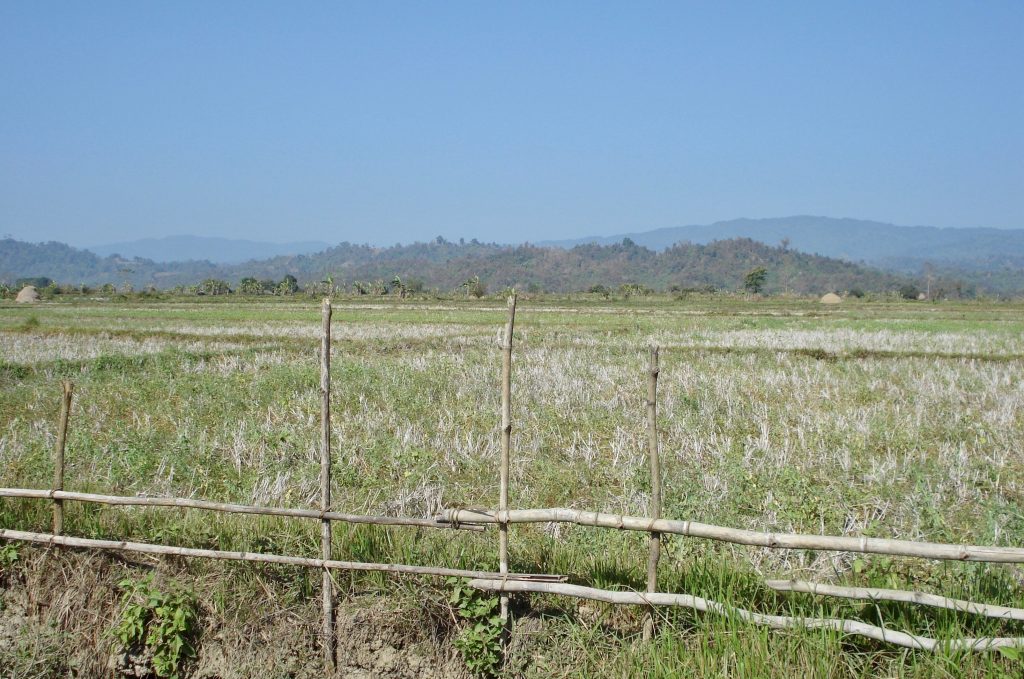
“We fared no better than our animals as we struggled to keep our balance in the slippery, cloying mud, which denied a secure purchase to our leading foot and yet refused to let go of our rear foot … we grabbed with one hand or the other at any convenient branch or bush to steady ourselves. Occasionally, you would miss your footing, or slip in the mud and end up on your hands and knees, under your 60 lb load, and then have to drag yourself painfully to your feet once again …”
When high in the Gangaw Range, they halted for a 24-hour rest and a supply drop. It was only at that point that they learnt that they were now part of 111 Brigade, contributing to Blackpool’s garrison. The next two days’ marching brought them within four miles of Blackpool. The jungle thinned and the final stretch would have to be covered in the open – an unpleasant prospect for men accustomed to the protection of thick jungle. At that point, however, they were lucky enough to ford the Namyin Chaung just before it ballooned into a monsoon torrent, bursting its banks and becoming a mile-wide barrier of flooded ground – isolating 77 Brigade from its support role at Blackpool.
Jack Masters was much concerned about Blackpool’s vulnerability. He flew out for a meeting with Stilwell and Lentaigne and asked for 14 Brigade to speed up. Lentaigne told Masters that he could abandon Blackpool if 111 Brigade found itself on the brink of destruction – not exactly an encouraging comment.
Unpleasant surprises came in many forms at this time. John Riggs’ 16 Column Recce Platoon (14 Brigade) were exploring Indawgyi Lake’s western shore: “We reached a village about halfway along the lake shore. This was a big village but with no sign of life and we became cautious. We kept it under observation for about half a day, then decided to move into the outskirts. I took a small party, including a few Burma Riflemen, with me. We kept a low profile for another hour or two, then spotted a Buddhist priest in the local temple. We approached for a chat, only to find that he and the others had smallpox. They were a nauseating sight but we needed answers to the usual questions: ‘Any Japanese?’ ‘Any food?’
“We contacted the Column by wireless during the midday halt and reported smallpox in the village, as the entire Brigade would be advancing in that direction. A special airdrop then included supplies of smallpox vaccine. All duly received smallpox booster shots and our doctor even vaccinated villagers who emerged from the surrounding jungle. Only the Recce Platoon was not vaccinated! We pressed on and reached the north of the lake.”
The Recce Platoon’s travails continued: “The going was very marshy. As we left the lake and moved north a sharp report made us take cover. We had not been fired on. Instead, the Sapper Officer following me had stepped on a booby trap. This nasty gadget put a bullet in his leg when he put his weight on it. He hobbled back and we took it in turns to help him along. By the time we were out of the thick jungle area we were covered in leeches. Cigarettes were used to remove around 80 from my body alone. I then awaited further instructions. Eventually, sections of the column’s main body joined me and I was able to hand over our wounded Sapper. That booby trap was American!”
When the monsoon broke on May 15, many men were delighted with the slightly cooler atmosphere. Being soaked and surrounded by thick mud soon changed their minds. The impact on supply drops was dramatic. The men soon found that five days’ rations might have to last up to 14 days. The drops had to be flown in daylight, but blankets of low cloud often hid the signal fires. Some lucky individuals received American jungle hammocks. Fred Gerrard, of the York and Lancaster’s 84 Column, described the lot of the less fortunate: “The remainder, if they had an extra groundsheet – between two – constructed a shelter to give some protection from monsoon rain at night. Otherwise, it was sit on your pack, with back to a tree, groundsheet around your shoulders, bush hat on your head and hope for the best.”
Many men harboured fears of being left behind due to wounds, sickness or exhaustion. Now the arrival of the monsoon aggravated those fears. The unspoken question on every mind was: “What will happen if we can’t fly out the wounded?”
—ooo—
111 Brigade was now at grave risk. Morris Force cut the Myitkyina road to the east and 14 Brigade and 3(WA) Brigade moved north, to do what they could to help. Calvert’s 77 Brigade now had a tough dual assignment, to take Mogaung and help protect Blackpool. However, the latter became impossible when the Namyin river flooded, creating an impassable flooded area. While 14 Brigade and the West Africans secured the vital Kyunsalai Pass, they failed to get close enough to provide significant support for the Block.
The Japanese, meanwhile, had taken on board the lessons of White City. They now prepared to crush the much weaker Blackpool Block. Conditions within the new Block deteriorated rapidly in the monsoon. On May 16 Japanese troops penetrated the defences and a counter-attack failed to eject them. Now many positions within the perimeter came under persistent sniper fire. Shelling that evening heralded another attack. It was beaten back, leaving 50 Japanese dead. This was followed by a night attack involving two companies. This was repulsed, the enemy losing another 70 men. The next two days were relatively quiet, although sniping and shelling inflicted more casualties.
Despite the heavy pressure on the wire, patrols went outside. On May 15, a King’s Own patrol attacked a Japanese unit outside the wire. Inside the perimeter, Norman Campbell, with the Cameronians’ 90 Column, settled in with Cypher Corporal Eddie Walsh: “We dug an L-shaped trench about 4 ft deep, with each arm long enough to provide a ‘bedroom’. There was a ramp at one end, allowing us to run down, rather than jump in and risk injury. When the Japs shelling got worse, we deepened it to 5 ft.
“Tea was always available. There were no restrictions on fires in broad daylight, as the Japanese knew where we were, but no fires were allowed after dark. Eddie and I got familiar with the local layout. Blackpool Block was a range of small hills, like the splayed fingers of a hand. Between the small finger and the ring finger was the 25 pounder battery. Looking across the valley, at about 2 o’clock, was the railway station and road. Almost every day, just as we were about to eat our meal, the wind switched to the north and brought with it the smell of the rotting bodies of Japanese who had tried to join us on previous days. I can still smell it.”
Blackpool was supposed to be shielded by “floater” columns but it wasn’t long before everyone available was needed inside the wire. Corporal Fred Holliday, of the King’s 82 Column: “… we soon became ‘locked in’ by Japanese pressure … It was sheer bloody hell at Blackpool, particularly with that 150 mm mortar. Things went from bad to worse very quickly. We didn’t regard Blackpool as a ‘Block’ in the full sense of the word. The Japanese brought up a tremendous amount of stuff. Blackpool was clearly unsuitable. Perhaps Masters was unlucky or simply didn’t have the time to make a better choice of sites. It seemed to me that we couldn’t make a move without the Japs knowing.”
Bill Smyly was concerned for the mules: “At Blackpool the mules were shackled for safety in the bottom of steep gullies. Some died there in the shelling and it took three days or less for the flies to reduce their flesh to pools of swimming maggots and an indescribable stench of putrefied flesh.”
Captain Bill Towill later wrote down his first impressions of Blackpool: “The morale of the men was at rock bottom – but who could blame them, after what they had been through? The place was pervaded by the overwhelming stench and sight of death, putrescent human remains and desolation. It was a sea of slippery mud, churned up by shell and mortar fire. In ‘The Deep’ John Thorpe and B Company took over from the Cameronians and Scott Leathart with D Company took over in ‘Pavilion’. As he did so, Scott came across a British soldier sitting in his slit trench and looking out over the valley. He took no notice as Scott jumped into his trench and asked what he was doing and then, when Scott tapped him on the shoulder, he rolled over sideways, stiff with rigor mortis. “There was no obvious wound or other indication as to how he had come by his death, but what was equally chilling was that he should have been left there by his comrades and officers, who seemed not to have noticed or cared.”
Many of the defenders harboured growing fears about Blackpool’s prospects. Norman Campbell and those around him awaited the next attack as dusk approached: “The attacks began with yells and ended with screams as they were stopped by the machine guns. The Japanese never penetrated the wire in our sector. At that stage we were still confident, but most of us felt this was a bloody silly place for a Block. All the Japanese had to do was shell and starve us out.”
Blackpool’s four 25 pounder guns achieved some significant successes, on one occasion destroying an entire train. Yet Monsoon conditions turned Blackpool into a quagmire, making it difficult to move around.
Elsewhere, General Stilwell’s forces had an unexpected success on May 17, with the capture of Myitkyina West airfield; anti-aircraft guns and reinforcements were flown in. However, Stilwell and the Chinese 150th Regiment failed to take advantage and use it as a springboard to take the town itself. The Japanese then increased Myitkyina’s garrison from 1,000 to 3,000 and the town held out for another 70 days.
Back at Blackpool, things continued to deteriorate. Blackpool mattered as it was just 40 miles south of Kamaing, Stilwell’s next objective. If the Block fell, more Japanese troops would be released, making it even harder to take Kamaing and Myitkyina. On May 17, Slim placed the Chindits under Stilwell’s command. This was to have catastrophic consequences for Special Force.
On May 19 111 Brigade’s Jack Masters visited the Shadazup headquarters of Lentaigne and Stilwell. He described the precarious situation at Blackpool. While he was given permission to evacuate in extremis, Stilwell made clear that he still expected the Chindits to hold the Block. Meanwhile, 77 Brigade, stuck by floodwaters to the east of Blackpool, had no success in their efforts to help the Block’s garrison. More than a dozen attempts were made to cross the mile-wide floods.
The problems of Michael Calvert’s command meant little to the King’s Own at Blackpool. They were too busy trying to stay alive in “The Deep”, where they came under constant heavy attack. Air support helped repel successive waves of attackers. Mustangs and Mitchell bombers made high speed runs along the narrow valley separating the King’s Own trenches from the enemy. The air strikes were intense throughout May 18-19.
Yet the Japanese were remorseless. They hit the King’s Own again in a fierce night attack, rushing the wire with no thought of casualties. 111 Brigade’s Richard Rhodes James: “We were holding and killing, but we were also tiring. The firing used to start at dusk. First the 105mm, then the 75mm, which gave us little chance to go to the ground, the mortars, the grenades and, finally, the machine guns. There was an expectancy with each dusk, waiting for the distant thud and whine, the sharp bang and explosion of the ‘whizz-bang’, the more open crash of mortars and grenades. Men charged the wire and died as they tried to get over, men blown up on our mines or maimed by our booby traps. With the morning came relief but also an overriding weariness, fatigues on the airstrip, digging and guarding. The King’s Own were being steadily worn down and they knew it.”
The King’s Own continued to get the worst of it. The 46 Column Chindits sitting in their slit trenches included Private Jim Unsworth: “Most of our Battalion were dug in below the hill. The King’s Own really caught it when the shelling got worse. We were confident, however, as our defences were strong and we had plenty of wire. Yet ammunition and supplies began to run out when the planes couldn’t get in due to the Monsoon. After the Japs overran the strip we had no food for around three weeks. We knew we couldn’t hold. We did very well to hold them that long.”
The final phase of Blackpool’s occupation approached, with repeated episodes of savage hand-to-hand fighting. Bill Smyly was at “Silly Point”, during a particularly determined attack. He saw a sword-wielding Japanese officer hacking at someone in a trench, 50 yards away, to his left: “It was a Forward Observation Post for our guns and the Jap was in a frenzy. He looked like he was beating a dog with a stick. I was on the Bren at the time and I gave him a burst.”
Smyly noted that the intense fighting rapidly consumed much of the Block’s remaining ammunition and food. He was moved by the gallantry of the C-47 crews: “Despite their heroism, we were running out of ammunition and had been without food for days. The end was quite close. By now the enemy had got the measure of us and had brought up AA guns to deal with the supply aircraft.”
During the final day or two at Blackpool, not a single air support sortie was flown. This left the Japanese free to bring up artillery and anti-aircraft guns and allowed them to overrun the airstrip. The lack of floater defences and air support and supply proved fatal to Blackpool and many members of its garrison. During one of the last attempts to drop, 11 of the 12 aircraft involved were hit by AA fire. Night drops were impossible due to the weather.
The King’s Own positions remained the most unpleasant in the Block. “The Deep” was at the bottom of a very steep, muddy slope. Much of this area had flooded as the Monsoon rains continued. Bill Towill saw more Japanese attempts to break in: “We received almost continuous shell and mortar fire and were under heavy attack, day and night. Dog-tired and wild-eyed, we fought desperately to keep them at bay.”
Later, Towill wrote graphically of the sufferings of the King’s Own: “Night after night the enemy came in at The Deep, no longer in Platoon strength but in Company strength and with set purpose. The King’s Own kept holding and killing as one fanatical attack followed another … on May 17 their positions in The Deep were probed systematically by at least 12 pieces of Japanese heavy artillery and their Second in Command reported that there had been direct hits on his machine gun posts, killing their crews, and he doubted whether they could hold another enemy attack. Masters relieved them with the Cameronians and, as the King’s Own passed him, they were walking like Zombies, wild-eyed, their jaws sagging wide, obviously right at the end of their tether.”
Blackpool Block’s interior was now a moonscape of mud and shell holes. Captain Miller, the King’s Own Chaplain, struggled to keep up with the burials: “I was working single-handed at this unpleasant task of transporting the dead or what remained of them to the burying ground when I noticed a body covered over with a blanket which seemed to me to show signs of life. As I gently uncovered the poor, battered face, I could see there was life, for he, whoever he was, was still breathing. I ran or stumbled as quickly as I could through the mud and filth to the main Dressing Station and blurted out what I had found to the Senior Medical Officer. I was told that this particular man had no chance of living and had been placed in the mortuary to await death and his turn for burial. There were so many casualties that bodies had to be left for several days.”
Everyone went hungry in the Monsoon – the now desperate garrison at Blackpool and the men of three other Brigades, 77, 14 and 3 (WA). 14 Brigade’s Columns had fought to position themselves to defend Blackpool but the terrain, mud, flooded chaungs, lack of food and disease undermined their capabilities.
Major Paddy Dobney, with the York and Lancaster’s 84 Column, described the conditions of slow starvation and noted how appetites increased sharply when marching at over 3,000 ft: “With half rations of only 2 oz of meat hash or cheese and two finger biscuits per meal, we were very hungry.” They were still four days away from the site selected for the next drop. Dobney managed to cadge one K-ration for 400 from another column when that drop was cancelled. It was a “loan” and had to be repaid when the drop finally came, on May 21.
—ooo—
Jack Masters, commanding 111 Brigade, took stock of the situation. There was fighting around Myitkyina and Stilwell’s Chinese were still held up north of Kamaing. Meanwhile, the Japanese were still attacking Blackpool. On a positive note, on May 21 74 Column (7th Leicesters) won the race with the Japanese for the strategic Kyunsalai Pass, overlooking Hopin, Ywathit and the railway corridor. The enemy arrived an hour later but were beaten off with the loss of 60 dead.
For another three months or more the Chindits would stay in, through the Monsoon rains. The effects were disastrous for both men and animals. Mules weakened and died of exhaustion. Some sank deep in the mud and could not be freed; they were shot as an act of mercy. Lieutenant-Colonel Graves-Morris feared for his men and he spoke of harsh but little known truths: “We were all to see once robust men waste away to skin and bone and to fall from weariness and exhaustion, to die before they could be evacuated. We were all to see the devastating effect continuous rain, jungle gloom, mud and toiling, back-breaking marches were to have on men’s minds, as many normal, cheerful men … collapsed and asked to be left to die or even hastened their end by their own hands.”
In this grim situation, aggravated by the Monsoon, Lentaigne, the Special Force Commander, seemed unsure of how to use 14 and 3 (WA) Brigades. Blackpool Block was now isolated and vulnerable. A brief lull in the fighting ended on May 22, when a large Japanese patrol attacked airstrip working parties. They were driven off, with 50 killed, but returned in strength the following morning. Major elements of the Japanese 53rd Division reached Blackpool, bringing up anti-aircraft guns, field artillery and the much hated 150 mm mortar. Blackpool’s garrison now faced an all-out assault by 128th Regiment. 14 and 77 Brigades, together with the Nigerians, were unable to get near enough to help. 111 Brigade Commander Jack Masters still nursed the hope that 14 Brigade, at least, would be able to intervene.
The King’s Own, who had suffered severely defending “The Deep”, now had a new role, in a semi-floater role around “Parachute Ridge”. Their job was to challenge Japanese units forming up to attack the Block. There were not enough men to fully man the defences; the southern sector was lightly defended as it was assumed (wrongly) that the enemy would not attack up the steep slope from the airstrip. The Japanese shelling grew in intensity and the enemy’s anti-aircraft guns effectively closed the Dakota strip. The Block’s supplies dwindled and the wounded and sick could no longer be flown out. Then an assault across the airstrip, on May 23, forced the British gunners to abandon the Bofors.
The men could read the situation for themselves. Peter Heppell, an NCO with the King’s 82 Column, was wounded. The Sappers were on top of a ridge, looking down on the attacking Japanese and under mortar fire. “There was an almighty explosion from a mortar bomb. I was thrown back on the bank, with shrapnel in the left leg. The metal is still there. I felt relieved that the fragments had missed the three primed grenades in my pocket. I put a field dressing on my leg and hobbled towards the First Aid Post. I had just one thought in my mind: ‘The only way to get out of here is to walk. The most important thing was to avoid a leg or foot injury.
“Looking round, inside the post, I saw that my problem was superficial. Some people were in a shocking state. Outside, I saw a Dakota make a low pass, dropping supplies. I saw the guy at the aircraft door. I was gripped by the thought that this wasn’t going right. I said to myself: ‘If this is going bad, I want to be with my mates’.”
Vickers gunner Frank Anderson, with the King’s other Column, 81, also knew things were going badly: “Once we arrived at Blackpool we were, in effect, locked into the perimeter by strong Japanese pressure. We had nearly three weeks of fighting at Blackpool and things were very rough. We made widespread use of sharpened bamboo pangis, to help keep the Japanese out of our positions. A lot of men were killed by high velocity guns, mortar bombs and in hand-to-hand fighting. Around 200 of our men were killed in action at Blackpool. I saw a lot. I was detached for many burial parties. The bodies were buried in shallow graves.”
The 25 pounders were busy on May 22, destroying a train (55 HE rounds), six trucks carrying troops and equipment (40 HE rounds) and a unit of 105 mm guns (46 HE rounds). That evening, Jack Masters placed a restriction on 25 pounder ammunition expenditure. Nevertheless, during the night of May 22/23 the guns fired 28 rounds against a convoy of 30 trucks.
Corporal Fred Holliday, with the King’s 82 Column, also worried about ammunition shortages: “I don’t remember feeling really hungry – I was probably too afraid. Conditions were appalling. As soon as you dug a slit trench it filled with water … I really began to doubt that we would get out alive.”
The British mortars rapidly consumed available bombs, leaving just a bare minimum in reserve. The Japanese continued shelling, probing and wearing down the defenders. The last attempt at dropping supplies involved three aircraft and one was shot down. Most of the drop fell outside the perimeter and the result was just one meal pack per man and enough ammunition to keep going for another 24 hours. There would be no more ‘chutes floating down over Blackpool.
The main Japanese attack on May 23 came at 18.00, hitting the relatively weak southern perimeter. The attackers were beaten back but every man was now called back inside the Block. The crisis was coming to a head, with ammunition now at a dangerously low level. During the day the Japanese had broken in and began to capture individual features. Things deteriorated during the night. The defences continued to crumble as the remaining positions held by the defenders came under increasingly intense fire. During the following day, May 24, some 600 shells exploded inside the perimeter. Bill Towill: “The night of May 24 was the very worst we’d experienced. All around the perimeter the enemy came at us again and again, remorselessly and relentlessly, taking all the devastating fire we poured at them and still coming back for more. We were taking heavy casualties, but their casualties must have been quite horrendous.”
At 05.00 the Japanese seized another position and advanced rapidly east and south as the defences progressively collapsed before them. Masters faced up to the fact that evacuation was now inevitable. The main Japanese force was positioned in a half circle around the Block and continued to press the defenders, forcing them to further deplete their meagre ammunition stocks during the night of May 24/25. The end came when the attackers smashed through and the counterattacks failed, with the Japanese having no qualms about shelling their own troops whenever a captured feature was in danger of being retaken. The Block’s survivors now had no food and sufficient ammunition for only 12 hours of fighting. Masters gave orders for the withdrawal. When U Troop heard the news, their guns were still firing. They had no time to spike them.”
Hundreds of men now began a long and difficult hill climb away from Blackpool as it was overrun. At 08.00 Masters ordered the withdrawal of all sick and Brigade HQ. The struggle to reach the rallying point of Mokso Sakan, east of Indawgyi Lake and about 18 miles away, was now in progress. A way through the encircling Japanese was found. The path was accessed via “The Deep”. The large number of wounded presented a serious problem. Bill Towill described how the decision was taken to leave no-one alive for the Japanese:
“Those who had a reasonable chance of survival we took with us. There were about 60 severely wounded, on stretchers or pony-back, and a hundred walking wounded … but some were in extremis, were either already dying or very close to the end and would not be able to survive the long and hard haul over the mountains to Mokso Sakan.
“It was quite unthinkable that these should be left for the Japs, who would have slaughtered them brutally, going out of their way to inflict the maximum suffering and humiliation. They were quite implacable, without a shred of compassion or humanity, and we knew of previous occasions when they had overrun our hospitals, butchering staff and doctors as well as sick and wounded. What could not be avoided had to be done and those desperately ill men, about 18 of them, were put out of their misery with a shot to the head, before the survivors left the Regimental Aid Post for the last time.”
Jack Masters wrote: “A doctor spoke to me – ‘Will you come with me Sir?’ I followed him down the path. It was clear of moving men. The whole Block was clear, except for a part of 26 Column. A little way down the path we came to 40 or 50 ragged men, many slightly wounded, who had carried stretchers and improvised blanket litters from the Main Dressing Station as far as this. Here they had set down their burdens and now waited, huddled in the streaming bamboo, above and below the path. I noticed at once that no-one looked at me as I stepped among them with the doctor.
“The stretchers lay in the path itself and in each stretcher lay a soldier of 111 Brigade. The first man was quite naked and a shell had removed the entire contents of his stomach. Between his chest and pelvis there was a bloody hollow, behind it his spine. Another had no legs and no hips, his trunk ending just below the waist. A third had no left arm, shoulder or breast, all torn away in one piece. A fourth had no face and a whitish liquid was trickling out of his head into the mud. A fifth seemed to have been torn in pieces by a mad giant and his lips bubbled gently. Nineteen men lay there. A few conscious. At least their eyes moved, but without light in them.
“The doctor said: ‘I’ve got another 30 on ahead, who can be saved if we can carry them’. The rain clattered so loud on the bamboo that I could hardly hear what he said: ‘These men have no chance. They’re full of morphia. Most of them have bullet and splinter wounds beside what you can see. Not one chance at all, Sir, I give you my word of honour. Look, this man’s died already, and that one. None can last another two hours, at the outside.’
Masters told the doctor: “Very well. I don’t want them to see any Japanese.” The Brigade Commander was then told that there was very little morphia left. He told the doctor: “Give it to those whose eyes are open.” He heard the shots as he went back up the ridge.
Frantic efforts were made to find more stretcher-bearers and all the fit men of the 25 pounder crews were pressed into service. Blackpool’s fall was sudden, traumatic and bloody. Each death became a family tragedy. Frank Anderson, a Vickers gunner with 81 Column: “When we had to go we left several wounded behind. They were just lying there, on the ground. They included my friend George Charnock. George was a nice fellow – we got on well together. He was in our Mortar Platoon. He had been bayonetted and was dying when I left his side. I got a letter from his parents, who knew I had been with him. I couldn’t go and see them and I couldn’t even bring myself to reply. I knew I would break down if I visited them. I just couldn’t face it.”
Some men found an iron resolution to live. Some crawled on the track, to make their escape. Captain Neville Hogan, 46 Column Recce Platoon Commander: “At one point I heard screaming – the incoming Japanese were bayonetting our wounded on the other side of some bashas. I saw remarkable things. One King’s Own Sergeant Major, CSM Robson, MM, was hit in the ankle. He was determined to live but refused to be helped. He took off his boots and socks, wore them on his hands and then moved off on his bum. He survived Blackpool.”
Bill Smyly came across eight men attempting to carry a man through the thick mud. “I watched as the wounded man tumbled out and fell heavily to the ground. He was screaming, not loud but in agony, in a way I can’t describe. His arm had been blown off and the top of his shoulder gone.” There was another officer at the scene: “I suppose we should have told the men to move on, or what to do, but it didn’t work like that.” The eight men slipped away and Smyly and the other officer carried the man down to the bottom of the hill, where they put him down: “The wounded man was a Scotsman. He was in deep shock and trauma, probably feeling little pain. I knelt at the head of the stretcher and spoke to him. I asked him where he was from and said he would soon be back there. He was on the stretcher, looking up at the sky, I was at his head, kneeling to talk to him. I shot him in the middle of the forehead. It was the way we shot the mules. I closed his eyes.”
Smyly and many others regarded their escape from the Block as a true miracle: “Perhaps the Japanese didn’t want to chase us too closely. They may have lost quite a number themselves. I don’t know how many there were; they came after us with little rising sun flags. The way through the long grass was lined with abandoned stretchers – the wounded looking up at us, expressionless, as we walked past and abandoned them. You could see the flags behind you, coming through the grass … I don’t think anyone has ever explained how we got out so lightly. We made our way through tall elephant grass, on flat ground, with the little Japanese flags above the grass about 60 yards back. They kept their distance. Then we had to climb the open base of the foothills and they let us go. Not a shot. I don’t remember any firing. Why didn’t they fire on us? Getting out was a kind of miracle. Once we were in the hills and trees again, the Japanese didn’t follow.”
The escape required a gruelling climb of over 3,000 ft, a feat beyond some of Blackpool’s survivors. Some came under fire. Richard Rhodes-James: “There came a parting of the tracks, one leading through some tall grass to the left of a cluster of bashas, the other going across the paddy to the right of the bashas. Not knowing where I was going, I turned left. This was the most fortunate decision of my life. Few of those who turned right survived that day … finally, at the top of the slope, the path levelled off into the jungle and there was silence. The noise of war floated away and we were at peace. We had escaped the inferno and it was now just a terrible dream.”
Rhodes-James made a poignant summary of the escape from Blackpool: “By all the rules of war we were doomed, surrounded by the enemy 2,000 strong, who were fresh and determined. For two weeks we had beaten them off and could fight no more … when our fighters and bombers failed to turn up the enemy emerged and was free to roam at large. When the weather broke and the supply planes could only come by day, our days were numbered … we were faced with the alternatives, either to break out into the valley or escape into the hills and the peaceful seclusion of the Indawgyi Lake. To attempt the first would have been suicidal and the second could easily be countered. There was one main path out of the hills, which we took, a Brigade in single file, and the enemy allowed us to escape along that track, albeit at a cost. Perhaps it was a miracle; these things do happen and it would be rash to assume that the hand of God was not with us that day.”
The march to the Mokso concentration area involved immense suffering. Richard Rhodes-James: “Rations were almost non-existent and a collection was taken to provide for the wounded. Meals had to be reckoned, not in cartons, but in single biscuits or half tins … some walked who should never have left a stretcher, bandaged and with expressions of terrible resignation on their faces. One RAF Sergeant, I remember, who had been badly wounded in the head, tottered up the path with eyes that pierced you through with their pain. This man died walking halfway to deliverance on that rain-drenched mountainside.”
Private Jim Unsworth, of the King’s Own’s 46 Column, was a member of the last platoon to leave. Ten men under Major Openshaw formed part of the rearguard. They engaged the Japanese. Unsworth was told to investigate when it went quiet: “I didn’t think we’d get away with it as we were the last two of the rearguard and my companion had been hit.” Later he caught up with Openshaw and other members of the platoon. The tensions of the last days began to show: “We were going up a steep hill. The going was wet and boggy. I saw a man lose his temper with a mule. He began raining blows on it with his rifle butt. I said I would do the same to him unless he stopped. Then an officer came up and warned me that he’d put me on a charge if I didn’t let it go. I had grown very fond of the mules. Many survived Blackpool, as they were moved into safe harbour before the heavy battles began.”
Bill Towill recalled the struggle over the mountain range to Mokso Sakan and Indawgyi Lake: “The going was really tough. We were up to the top of our boots in mud most of the time and it was exceedingly difficult to keep your footing. We struggled on with the sweat dripping steadily from the tips of our noses, grabbing at branches to support and help us up.”
The reception for survivors was prepared by the West Africans. Their work included improving the track on the final stages to Mokso and assisting the traumatised survivors. The first to reach sanctuary with 6NR’s 66 Column were members of a forward patrol led by Major Reece of the King’s Own’s 41 Column. Then the rest of the garrison began to come through. Ragged and in a daze, they staggered up the track, the worst cases trailing at the end. They were the remnants of 48, 41, 46, 81, 82, 90 and 93 columns. There was no food to give them. Masters’ report to Lentaigne, made on May 28, put casualties from 08.00 May 24 to 08.00 May 25 at 120 killed, 60 wounded and 30 missing, with Japanese losses put at 350 killed.
The agony of Blackpool’s fall remained raw in many minds for decades. Bill Towill made a bitter observation: “The strong, wide-ranging and most effective Commando forces deployed at White City, or their equivalent, were totally absent and we were left by our General, who had not even visited us, or the other two Brigades, to sink or swim on our own.”
Michael Calvert, widely regarded as the ultimate Chindit fighting commander, paid a heartfelt compliment to 111 Brigade: “Masters and his garrison did magnificently under appalling conditions. It was to Masters’ credit that he held out so long. The (Japanese) 53rd Division lost over 500 casualties.”
Stilwell was furious at Blackpool’s evacuation, compounding his other misfortunes. The Japanese had reinforced Myitkyina and the opportunity was lost to take the town. The Chinese and Merrill’s Marauders were pushed out of Myitkyina’s western districts. Later, the Chindits were to do much of the fighting that should have been done by Stilwell’s Chinese, with Stilwell continuing to misuse what remained of Special Force as assault troops. Over 60 years later, a British veteran said, with utter sincerity, that he would have welcomed an opportunity to shoot Stilwell. That was not an exclusively British sentiment. It was also expressed by some of the abused Americans of Merrill’s Marauders.
—ooo—
When 65 and 84, the York and Lancaster Columns of 14 Brigade, got the news that Blackpool had fallen, they turned back from their effort to reach the Block and made for the Kyunsalai Pass. The Japanese wanted the Pass to reinforce the town of Kamaing against the advancing Chinese. The Chindits wanted to hold the Pass to prevent the Japanese securing the Indawgyi Lake area and threatening the evacuation of hundreds of wounded and sick. 84 Column’s Battle Group reinforced the Pass while 65 Column made for the Lake, to help prepare a reception area for wounded and sick. The Pass was now garrisoned by elements of six columns and Japanese pressure was increasing.
Lieutenant Ronald Bower, MO with the Bedfordshire and Hertfordshire’s 16 Column, was based at Nammun. He described conditions at the Pass as “rather like trench warfare”. He saw many cases of trenchfoot, jungle sores and “mud rash”. Bower ran an improvised “hospital”, dealing with around 20 wounded and sick at a time. Most were men with malaria, typhus, oedema of the legs and jungle sores. New cases arrived from the fighting area every day.
With Blackpool gone, Brigadier Calvert’s 77 Brigade was now tasked with taking the town of Mogaung. They had not been trained or equipped as assault troops. On May 21 the Gurkhas had reported 4,000 Japanese in heavily fortified positions around Mogaung. With Blackpool gone, the 53rd Division elements involved in its eradication were now free to further reinforce Mogaung. On May 27, Lentaigne ordered Calvert to take the town, regardless of the scale of opposition.
—ooo—

